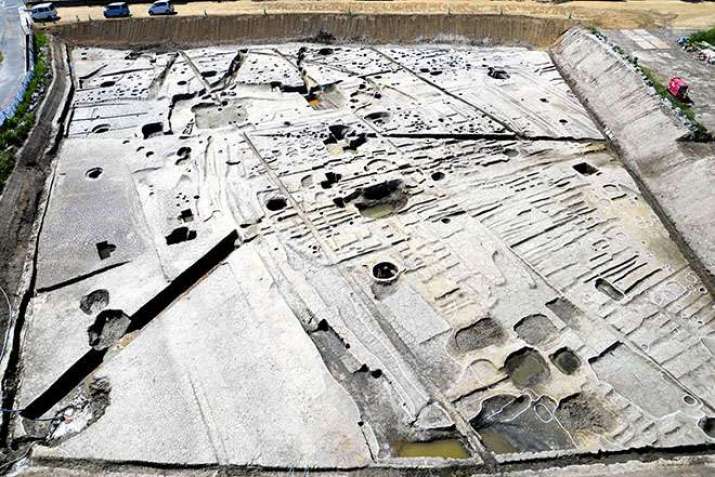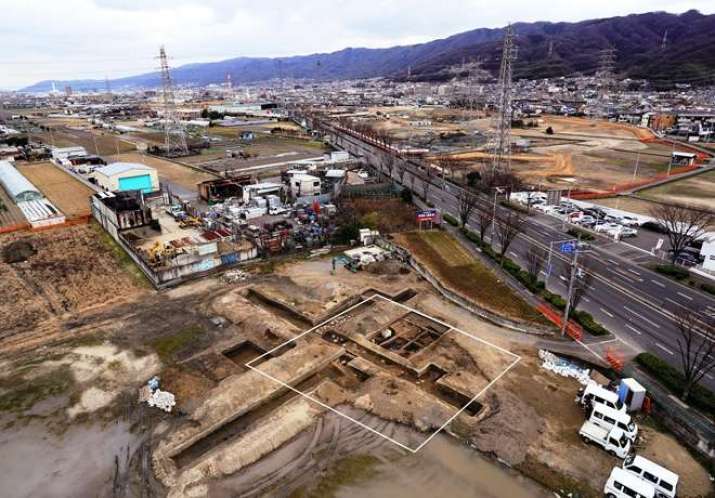NEWS
Japanese Archeologists Unearth Foundations of Ancient Second Capital in Osaka Prefecture
 Higashi-Yuge archaeological site. From asahi.com
Higashi-Yuge archaeological site. From asahi.comResearchers in Japan’s Osaka Prefecture have unearthed new archealogical evidence of ancient structures that they believe point to the existance of a fabled “second” capital city dating to the 8th century. The find at the Higashi-Yuge archaeological site in the city of Yao, comes six months after the discovery of the foundations of an ancient Buddhist temple thought to be Yuge-ji, a temple built by a powerful Buddhist monk named Dōkyō (c. 700–72) in the 8th century. The latest discovery seems to point to the existence of a mysterious second capital known as Yuge-no-miya, supposedly built during the late Nara period (710–84) by the Empress Shōtoku (r. 764–70).
According to the archeologists, the remains of an extensive trench and pits dug in the ground to support huge wooden pillars, together with the finds of last February, provide compelling evidence that construction of the second capital Yuge-no-miya at the site of the Higashi-Yuge ruins.
Until now, the existence of Yuge-no-miya has been shrouded in mystery. The name and location of the mysterious second capital are only known due to the Shoku Nihongi, an imperial historical text on the Nara period written during the Heian period (794–1185), which mentions both Yuge-no-miya and the adjoining Yuge-ji. No evidence of the existence of either the temple or the capital, however, had been found until this year.
According to historical accounts, Yuge-no-miya was commissioned by Empress Shōtoku—the 46th (under the name Empress Kōken [r. 749–58]) and 48th imperial monarch of Japan (as Empress Shōtoku)—but although a large part of the second capital was built, construction was never completed after her death in 770.
Empress Shōtoku is also well known for her relationship with the monk Dōkyō, whom she favored immensely after his devoted prayers for her health when she fell seriously ill. Dōkyō, who was promoted to the post of hoo—the highest rank among Buddhist monks—commissioned the nearby temple. When the empress passed away, Dōkyō fell from grace and died soon thereafter.
 Foundations of a pagoda found earlier this year at Higashi-Yuge archeological site. From asahi.com
Foundations of a pagoda found earlier this year at Higashi-Yuge archeological site. From asahi.comThe most recent excavations are just 500 meters northeast of the site where the temple’s foundations were discovered. Archeologists have unearthed multiple square pits, 60–80 centimeters wide, which are thought to have been dug to support massive pillars. The pits are aligned with the four cardinal directions, which, according Masanobu Hirose, a member of the Yao cultural property research council, is evidence of the existence of Yuge-no-miya at the site: “The site shows that there was very precise demarcation. . . . Yuge-no-miya, set out neatly in a grid pattern, must have sprawled to the area where archaeologists are now working.” (The Asahi Shimbun)
Masashi Kinoshita, professor emeritus of archaeology at Tokyo Gakugei University, is hopeful that the excavations at Higashi-Yuge will shed further light on the mysterious second capital. “Few details are known of Yuge-no-miya. The recent discovery of the canal may help unravel the mystery,” he said. (The Asahi Shimbun) Kinoshita was refering to the trench, 10 meters long and 1 meter deep, revealed at the second site, and a similar 60-meter trench that was discovered nearby last summer. Experts believe both trenches formed part of what was once a 600–700-meter canal that was used to transport building materials for the second capital.
“Workers need to transport building materials, such as large pillars and tiles, by water in short bursts, to efficiently construct key structures of a city based on meticulous planning,” said Kinoshita. “I believe that the trenches were most likely a portion of the canal built to transport building materials for Yuge-ji and Yuge-no-miya.” (The Asahi Shimbun)
See more:
Dig offers 1st hint of second capital in Osaka in 8th century (The Asahi Shimbun)
Related news from Buddhistdoor Global














